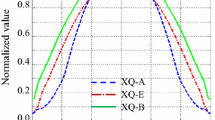Abstract
Today the Illumination most promising is the development of LED lighting devices. Therefore, urgent issues is an effective method of describing reflecting surface. In computer graphics recently started using free-form surface based on function disturbances. In this paper, the possibility of modeling freeform reflecting surface using functions disturbances. Freeform surfaces from scalar function disturbances do not require time-consuming for their modeling, regardless of the complexity of the form. The feature of this method is that the surface of that model, the surface should be zero of a function. So having trouble simulations surfaces of revolution. However, this problem can be solved by breaking surface modeling into several parts (patches) so that each point on the base surface meets only one point on the surface of the free-form, and then combining these parts. Methods describe the surface reflectance functions disturbances prefers correction form reflector only required site without changing the whole mathematical model in general. The work performed simulations reflecting surface parabolic form. For the performance of the functions of the disturbances, the surface was divided into two equal parts, which were described by the scalar function disturbances. The next step was the consolidation of reflecting surfaces of two parts one by logical operations.
Access this chapter
Tax calculation will be finalised at checkout
Purchases are for personal use only
Similar content being viewed by others
References
Benítez, P., Miñano, J.C., Bien, J., Mohedano, R., Chaves, J., Dross, O., Hernández, M., Alvarez, J.L., Falicoff, W.: SMS design method in 3D geometry: examples and applications. In: Proceedings of SPIE, vol. 5185 (2003)
Trafimuk, A.: How to Create Surfaces of Revolution via User Defined Objects. Zemax knowledge base
Budak, V.P., Mukhanov, P.V.: Modelirovaniye svetovykh priborov na zadannoye svetoraspredeleniye s pomoshch’yu V-splayn poverkhnostey. Rossiyskaya svetotekhnicheskaya internet-konferentsiya ‘‘Svet bez granits’’, Moskva (2009)
Ivliyev, S.N., Mikayeva, S.A., Shibaykin, S.D.: Razrabotka trekhmernoy triangulyatsionnoy modeli osvetitel’nykh priborov. Vestnik Moskovskogo gosudarstvennogo universiteta priborostroyeniya i informatiki. M. Izd. MGUPI (29), 16–22 (2010)
Korobiichuk, I., Bezvesilna, O., Ilchenko, A., Shadura, V., Nowicki, M., Szewczyk, R.: A mathematical model of the thermo-anemometric flowmeter. Sensors 15, 22899–22913 (2015). doi:10.3390/s150922899
Korobiichuk, I.: Mathematical model of precision sensor for an automatic weapons stabilizer system. Measurement 89, 151–158 (2016)
Kreyszig, E.: Differential Geometry (1991). ISBN: 0-486-66721-9
Vyatkin, S.: Complex surface modeling using perturbation functions. Optoelectron. Instrum. Data Process. 43(3), 226–231 (2007)
Vyatkin, S., Dolgovesov, B., Guimaoutdinov, O.: Synthesis of virtual environment using perturbation functions. In: Proceedings of the World Multiconference on Systemics, Cybernetics and Informatics, Orlando, FL, USA, vol. III, p. 350 (2001)
Craig, T.: A Treatise on Projections. University of Michigan, Historical Math Collection (1882)
Kushch, O.K.: Opticheskiy raschet svetovykh i obluchatel’nykh priborov na EVM. Energoatomizdat, Moscow (1991)
Author information
Authors and Affiliations
Corresponding author
Editor information
Editors and Affiliations
Rights and permissions
Copyright information
© 2017 Springer International Publishing AG
About this paper
Cite this paper
Kulik, N. (2017). Modeling of Freeform Reflecting Surface for LED Device. In: Szewczyk, R., Kaliczyńska, M. (eds) Recent Advances in Systems, Control and Information Technology. SCIT 2016. Advances in Intelligent Systems and Computing, vol 543. Springer, Cham. https://doi.org/10.1007/978-3-319-48923-0_72
Download citation
DOI: https://doi.org/10.1007/978-3-319-48923-0_72
Published:
Publisher Name: Springer, Cham
Print ISBN: 978-3-319-48922-3
Online ISBN: 978-3-319-48923-0
eBook Packages: EngineeringEngineering (R0)




